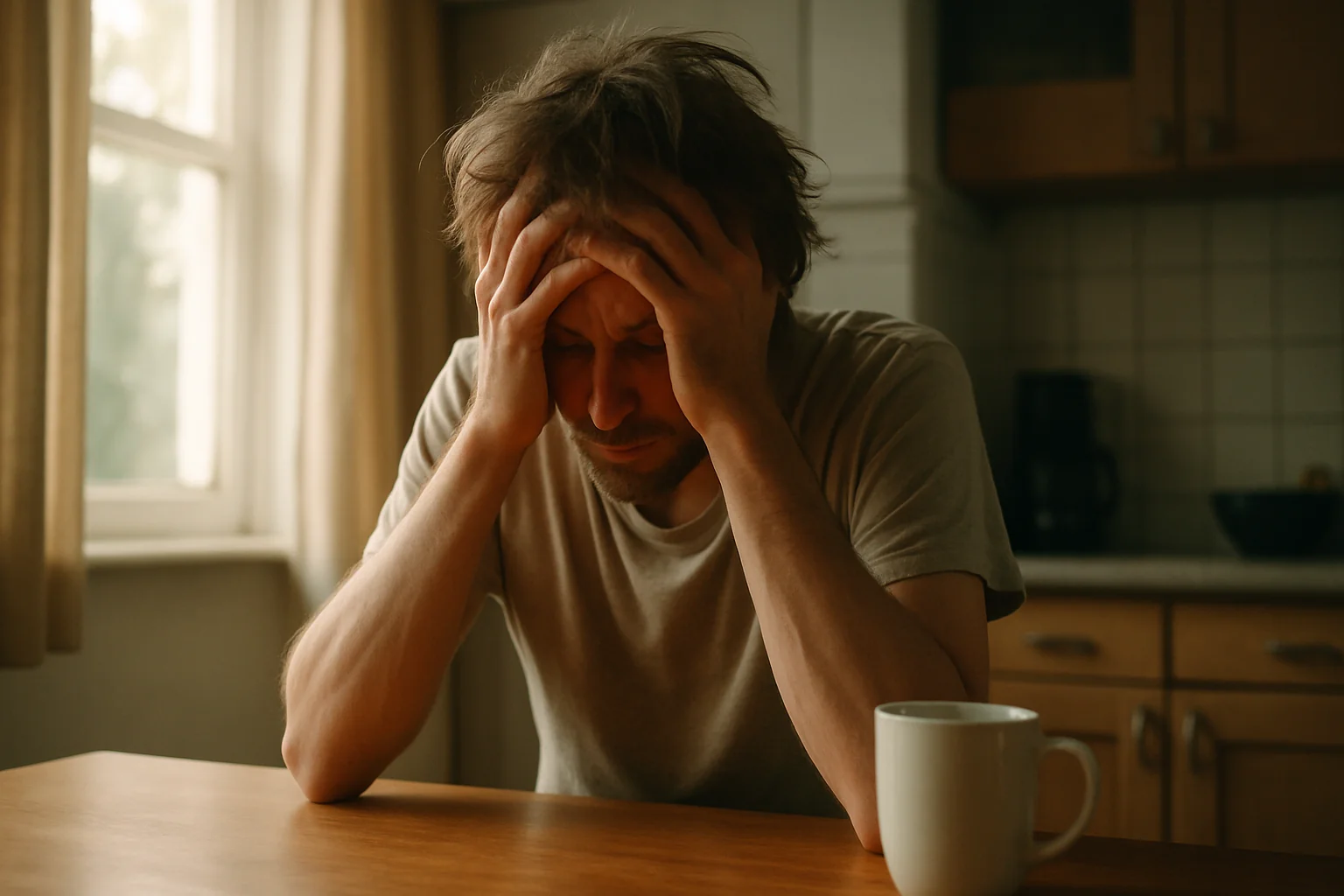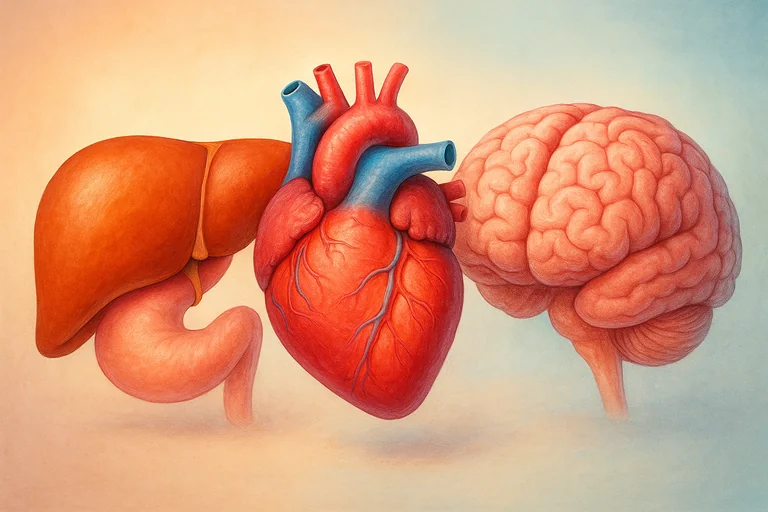A 2 minute assessment to get a personalized mental health or alcohol recovery plan.
Excessive drinking, defined by binge episodes reaching 0.08 percent BAC or heavy regular use, creates symptoms that masquerade as everyday problems including sleep that never refreshes, morning anxiety, cognitive slowing, rising blood pressure, weight gain, and relationship friction, with many people missing the connection until tracking reveals the pattern.
What You'll Discover:
- What counts as excessive drinking and why pattern matters more than daily use
- Early warning signs including sleep disruption, mood changes, and rising tolerance
- Body-level symptoms from cardiovascular to liver, immune, and hormonal effects
- Psychological and behavioral red flags that mean act now
- Step-by-step experiments to test if alcohol drives your symptoms
- Evidence-based treatment including counseling and naltrexone
Excessive drinking is more than "a few too many now and then." It's a pattern that, over weeks to years, rewires reward circuits, erodes sleep and mood, stresses nearly every organ system, and quietly damages relationships, finances, and work. The tricky part? Many symptoms masquerade as everyday problems: "I'm just tired," "work is stressful," "I'm not a morning person," "I must be getting older."
While definitions vary, these patterns commonly qualify: Binge episodes, quickly reaching a blood alcohol concentration around 0.08 percent (roughly 5 or more standard drinks for men or 4 or more for women within about 2 hours). Heavy/regular use: frequent drinking that exceeds low-risk guidelines (even if you rarely get drunk). Any pattern that repeatedly causes problems (health, mood, sleep, relationships, school/work, safety) even if total amounts look "moderate."
All that said, excessive drinking can exist with or without a formal diagnosis of Alcohol Use Disorder (AUD). What matters most is the impact on your body and life.
With that in mind, here's the full spectrum of symptoms tied to excessive alcohol use, how to recognize your pattern early, which signs mean act now, and evidence-based ways to change course safely.
The early, easy-to-miss warning signs
Sleep that looks long enough but feels awful - You fall asleep faster after drinks but wake at 2 to 4 a.m., toss and turn, or have vivid, anxious dreams. "Eight hours" on the tracker, yet groggy, irritable, or foggy in the morning. Snoring becomes louder; partners notice pauses in breathing or gasping. Why this matters: Alcohol front-loads sedation and back-loads disruption; over time it entrenches daytime fatigue and anxiety, which feed future drinking.
Energy and mood that keep sliding - Persistent low energy, motivation dips, and afternoon crash even on "quiet" nights. Morning anxiety or irritability ("hangxiety"), short fuse with family or coworkers. You feel socially "fine" while drinking but withdrawn or flat on off days.
Subtle cognitive changes - Word-finding gaps, slower recall, trouble focusing in meetings or lectures. Small mistakes snowball: missed details, emails you have to rewrite, forgotten commitments.
Cues of rising tolerance - The same amount no longer "hits." You pour a little more, start earlier, or add a final nightcap. Social plans feel less appealing without a drink to "take the edge off."
Weekend recovery routines - You plan whole mornings around recuperating (greasy food, naps, screen time). Workouts are cut short or skipped after drinking evenings; soreness lingers longer.
Body-level symptoms you can spot (head to toe)
Head, eyes, mouth - Morning headaches or "pressure" behind eyes even if hydration seems okay. Dry mouth and thirst overnight; sore throat from snoring or reflux.
Cardiovascular - Higher resting heart rate at night; palpitations after binges. Blood pressure creeping up at checkups, even if you're active and not gaining weight.
Metabolic and weight - Weight creep despite "not eating that much," especially central ("belly") gain. Strong late-night cravings; next-day sugar/starch pull.
Gastrointestinal - Reflux or heartburn worsened by evening drinks. Nausea, looser stools, or abdominal discomfort after heavier nights.
Liver and pancreas clues (early) - Right-upper-abdominal ache or fullness after drinking stretches. Itching without a clear rash; fatigue out of proportion to activity. Episodes of severe abdominal pain with vomiting (can signal pancreatitis and is an emergency).
Immune system - Frequent colds, slow-healing cuts, or more pronounced hangovers after modest amounts.
Hormonal and sexual health - Lower libido, erectile difficulties, menstrual irregularities. Sleep-related hot flashes or night sweats that track with drinking days.
Skin and appearance - Flushing with fewer drinks than before. Spider-like red vessels on the chest/face; red palms; easy bruising if disease advances. Puffiness around the eyes, especially after late nights.
Psychological and behavioral symptoms (the everyday life part)
The control problem (even at moderate totals) - You intend to have one or two, but most weeks it becomes three or four, or you add shots. "Screw-it" moments: a stressful day instantly resets your plan.
Blackouts and memory gaps - Conversations, texts, or parts of the evening you don't recall, even though you were awake and social. (Blackouts are not "just drunk"; they're a sign of brain risk.)
Planning life around alcohol - Picking restaurants by the cocktail list; choosing activities that include drinking; discomfort at events without alcohol.
Social and work friction - Subtle withdrawal from alcohol-free friends or activities. Missed morning meetings or "camera-off" days due to fatigue. More apologies for being short, late, or forgetful.
Money and logistics drift - Delivery app receipts spike on drinking nights; you make impulse purchases. You keep spares (bottles or flasks) "just in case," or stash them out of sight.
Red flags that mean take this seriously now
Blackouts (memory gaps) with any frequency. Drinking to manage withdrawal symptoms (shaky, sweaty, anxious, can't sleep). Morning drinking or needing a drink to steady nerves. Injuries (falls, cuts) or driving risks after nights out. Work, school, or relationship threats because of drinking. Signs of organ stress: worsening blood pressure, frequent heart racing, abdominal pain, yellowing eyes/skin, dark urine, or pale stools. Severe mood shifts: escalating anxiety, depression, or thoughts of self-harm.
Any one of these is enough reason to rethink your pattern and speak to a clinician.
Withdrawal symptoms (recognize, don't white-knuckle)
If you stop abruptly after sustained heavy use, you may notice tremor, internal shakiness, sweats, nausea, headache. Anxiety, irritability, sleep fragmentation with early-morning wakeups. In more severe cases, elevated heart rate, rising blood pressure, confusion, or seizures.
Important safety note: Alcohol withdrawal can be dangerous. If you've been drinking heavily, don't quit suddenly without medical guidance. Clinicians can help you taper or arrange medically supervised withdrawal and then transition to relapse-prevention care.
How excessive drinking shows up on health checks
Blood pressure: trending up or harder to control. Liver tests: AST, ALT, GGT may elevate; bilirubin can rise with more advanced injury. Triglycerides: often higher. Glucose/insulin: worsened control, especially with poor sleep. Sleep apnea: louder snoring, witnessed apneas; home testing frequently positive in symptomatic drinkers. Weight and waist: gradual increase even without big diet changes.
You don't need abnormal labs to have a problem, but these data often validate what you're feeling.
Why excessive drinking causes such a wide symptom net (the short science)
Reward circuitry: Alcohol boosts endogenous opioid and dopamine activity, tagging drinking as "important" in memory and habit loops. Over time, cues (stress, Fridays, certain friends) automatically trigger urge. Sleep architecture: Alcohol shortens time to fall asleep but suppresses REM early, then causes REM rebound and awakenings later. Result: light, choppy sleep and next-day anxiety/fatigue, which increase urge later.
Metabolic tilt: Alcohol calories are dense (about 7 kcal/g) and burned first, suppressing fat oxidation for hours; with snacks and sleep disruption, the scale climbs. Airway/lungs: Upper-airway muscles relax, snoring and OSA risk increase; oxygen drops and arousals fragment the night. Cardio/liver/pancreas: Blood pressure trends up; inflammation and oxidative stress hurt liver and pancreas; acute flares (alcohol-associated hepatitis or pancreatitis) can be life-threatening. Immune/hormonal: Immune defenses blunt; sex hormones and stress systems become erratic, affecting libido, mood, and energy.
Self-check screens you can try today (not a diagnosis)
AUDIT-C (3 questions): frequency, quantity, and binge frequency. CAGE (4 questions): Cut down, Annoyed, Guilty, Eye-opener. Two or more concerning responses on either suggests you should talk with a clinician. Even one in a high-risk context (blackouts) warrants attention.
A practical, step-by-step plan to test whether alcohol is driving your symptoms
Step 1 - Map your true pattern (7 days) - Write down, for one ordinary week: Number of standard drinks per day (1 standard drink about 14 g alcohol: 5 oz wine, 12 oz 5 percent beer, 1.5 oz 80-proof spirits). Start time for the first drink; last drink time. Sleep (bedtime, awakenings, morning feel). Mood/energy (AM/PM), workouts, and any snoring or apneas noted by a partner. Food after drinks and spending.
Step 2 - Run two experiments (2 weeks total) - Week A (Alcohol-Lite): Max 1 drink on up to 2 evenings, finish 3 to 4 hours before bed, no binges. Week B (Alcohol-Free): No alcohol. Keep the rest of life stable. Compare morning energy, anxiety, sleep quality, BP if you track, workouts, and snacks.
Step 3 - Decide by data, not vibes - If your sleep, mood, focus, blood pressure, workouts, or snoring are clearly better in Week B (or A), alcohol is very likely contributing to your symptoms, even if you never considered yourself a "heavy drinker."
Symptom-specific playbooks (what to change first)
If early-morning wakeups and hangxiety are your big problems - Move drinks earlier and lower: last drink 3 to 4 hours or more before bed; 1 or less on routine nights. Build a 30 to 45 minute wind-down (dim lights, stretch, shower, easy reading). Fix mornings: consistent wake time plus bright light within 30 minutes of waking.
If snoring or possible sleep apnea is in the mix - Keep alcohol early and light; avoid bedtime drinks. Ask about home sleep testing; treating OSA (CPAP or oral appliance) plus earlier/lighter alcohol is a potent combo for energy and blood pressure.
If weight and late-night eating are your pain points - Choose neat/rocks/soda water plus citrus over sugary mixers; anchor to one pour. Eat protein plus fiber before any drink; pre-plan a light, high-protein snack if you tend to raid the fridge. Protect sleep (it governs hunger hormones the next day).
If blood pressure is creeping - Compare home BP on alcohol-free weeks versus social weeks. Adopt a two-drink maximum on special nights and avoid binges entirely; keep the last drink early.
If blackouts have occurred - Treat blackouts as a medical red flag. They imply neurocognitive risk. Avoid rapid intake or shots entirely; if blackouts persist despite reductions, seek clinical help now.
When you should seek medical care today
Vomiting blood, black/tarry stools, or severe abdominal pain. Seizure, confusion, or inability to stay awake after drinking. Yellowing of eyes/skin, very dark urine, or sudden belly swelling. If you anticipate severe withdrawal (history of seizures, delirium, or very high daily intake), do not attempt to stop alone, seek urgent medical guidance.
Changing course - what actually works (and lasts)
Counseling and skills (the foundation) - A clinician or counselor can help you map triggers (time of day, emotions, social contexts). Build refusal scripts and exit strategies for high-risk moments. Repair sleep routines so you're not leaning on alcohol to "turn off." Enlist family/partner support without blame.
Medication option many adults consider - naltrexone oral tablets - For many adults who are medically appropriate, naltrexone oral tablets, taken alongside counseling, can help reduce heavy-drinking days and craving by dampening alcohol's reward signal. Clinicians typically: Confirm you're not using opioids (to avoid dangerous interactions). Review liver history and may check liver tests. Discuss common side effects (often nausea, headache, fatigue early on) and usual dosing (commonly 50 mg daily).
People often notice that the "just one more" impulse is less sticky, making it easier to stay within limits or maintain alcohol-free stretches, exactly what your sleep, mood, blood pressure, and workouts need to rebound.
Important: If you've been drinking heavily, ask your clinician how to change safely. Alcohol withdrawal can be dangerous; medical guidance prevents complications and sets you up for a smoother transition to relapse-prevention care.
Frequently asked questions
Can I have excessive drinking symptoms without drinking every day? - Yes. Pattern and intensity matter. Binge-heavy weekends, client dinners, or a few nights of "just one more" can create the same sleep, mood, and blood pressure disruptions as daily use.
Isn't wine healthier than liquor? - For symptoms and risk, ethanol drives the physiology. Beverage type matters far less than dose, speed, and timing.
If my labs are normal, am I fine? - Lab snapshots don't capture sleep fragmentation, blackouts, blood-pressure swings, or evolving mental health impacts. Go by symptoms plus pattern, not labs alone.
What if I only notice problems during stressful periods? - That's common. Stress plus alcohol is a risk multiplier for sleep and mood fallout. Consider stress-specific plans (alcohol-free weekdays, scripted coping, early cut-offs).
How soon will I feel better if I cut back? - Often within days to weeks: fewer early-morning wakeups, steadier mood and energy, better workouts, clearer focus, and improved BP. If you've been drinking heavily for a long time, deeper normalization can take weeks, but the early wins arrive fast.
What if I keep slipping? - Slips are data, not failure. Re-map triggers at those times, strengthen your scripts and environment (no home stock, alternate beverages ready), and consider naltrexone oral tablets with counseling to reduce heavy-drinking days and craving.
Ready to understand where you stand?
Not sure if what you're noticing adds up to excessive drinking? Our quick, confidential alcohol assessment gives you a private, research-based readout you can share with your clinician, plus personalized guidance on safer next steps.
Start your 3-minute alcohol use assessment




